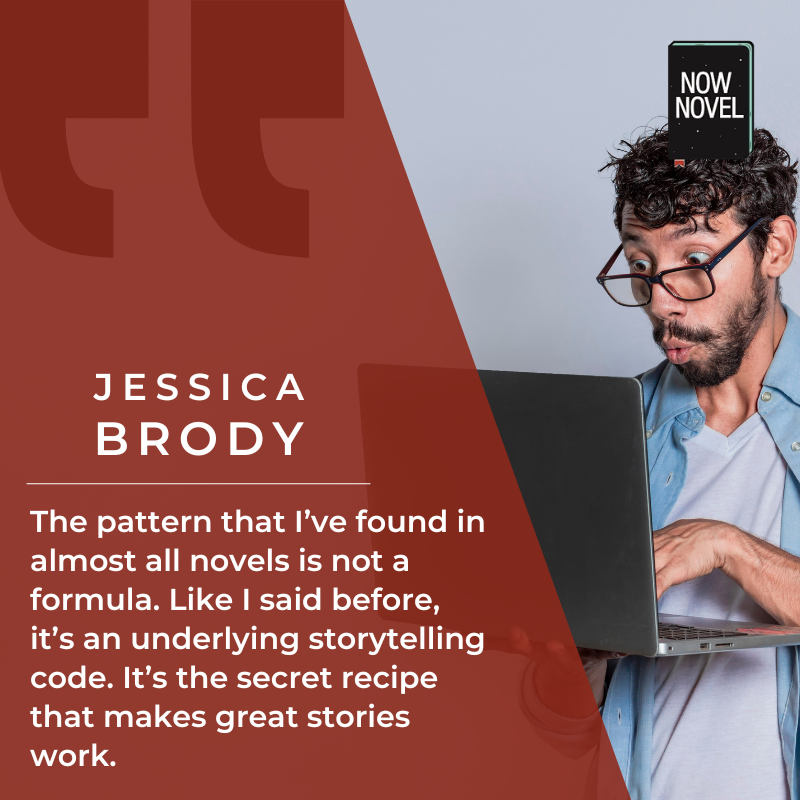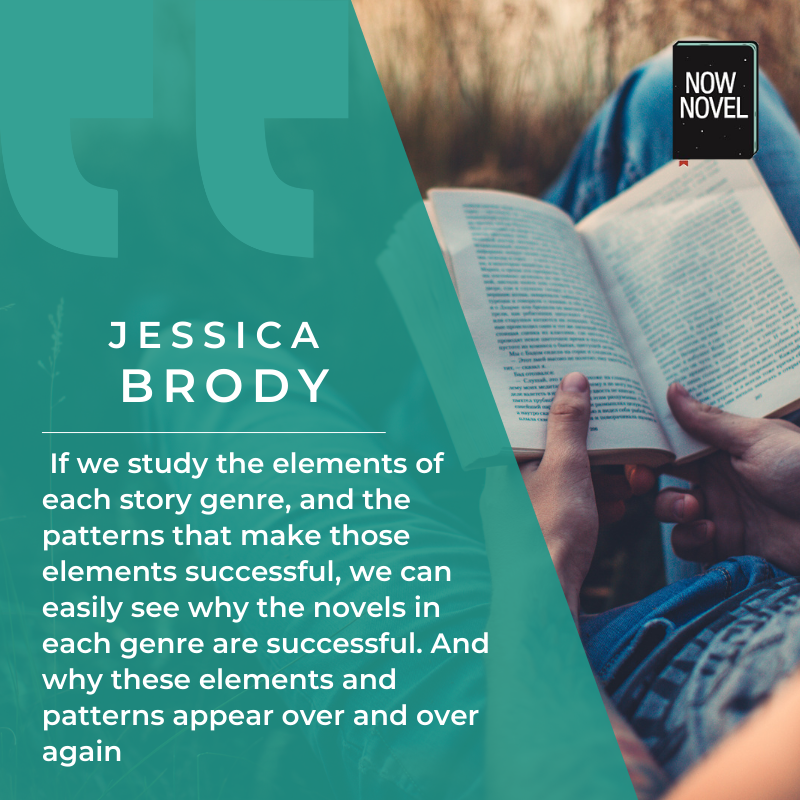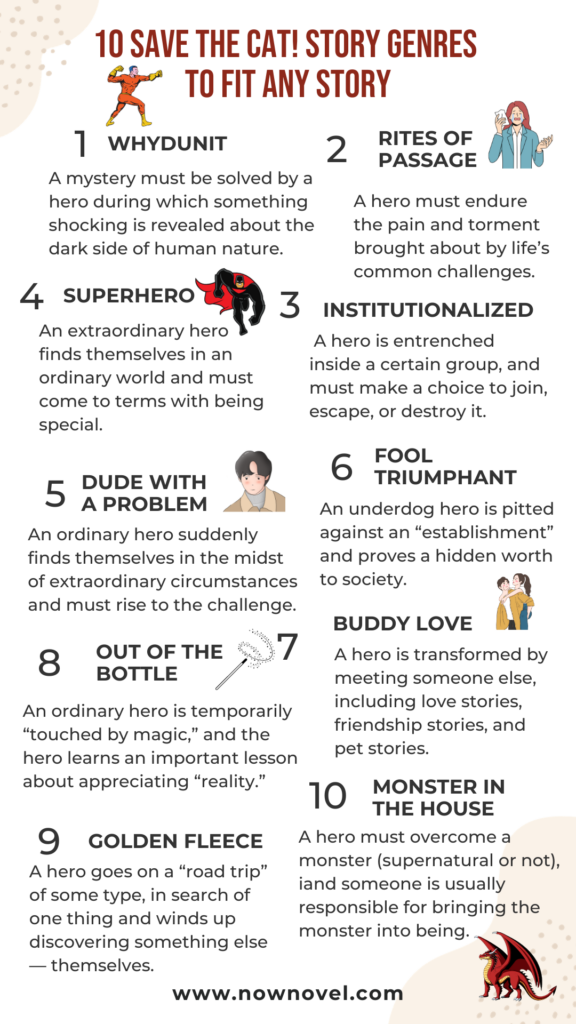Background to Save the Cat!
Firstly, here’s a bit of background on this technique for crafting a story. The “Save the Cat!” method was first created by Blake Snyder in 2005. A screenwriter and author he outlined this method in his popular screenwriting book Save the Cat! The Last Book on Screenwriting You’ll Ever Need.
In 2018 Jessica Brody published her guide, Save the Cat! Writes a Novel: The Last Book On Novel Writing You’ll Ever Need. Brody is an author, mostly of young adult fiction, she has also written two adult novels, as well as a writing instructor.
In her book Save the Cat! Writes a Novel she details the method, applying it to a range of novels, many contemporary, as well as some classics, showing that authors such Jane Austen and Charlotte Bronte also used this method. This was, of course, long before writing was ‘studied’ and writing courses and coaching was available.
As Brody puts it this method highlights three key points you need to consider when writing a novel: ‘Plot, structure, and character transformation. Or what I like to call the “Holy Trinity of Story.”
And if you’re worried about your writing being ‘formulaic’ Brody is adamant on this point:
The pattern that Blake Snyder found in almost all movies and the pattern that I’ve similarly found in almost all novels is not a formula. Like I said before, it’s an underlying storytelling code. It’s the secret recipe that makes great stories work.
If you want to call it a formula, go right ahead. But it’s a formula that can be found in the works of countless great authors including Charles Dickens, Jane Austen, John Steinbeck, Stephen King, Nora Roberts, Mark Twain, Alice Walker, Michael Crichton, and Agatha Christie. Regardless of what you call it, it works.
Making your hero likeable
Let’s have a closer look. She illustrates each step via three ‘acts’ in 15 beats (or plot points), breaking up the novel into these 15 beats.
In this method the protagonist is called “the hero” and that’s because the main premise of this method is that your hero has to do something remarkable to make them likeable to readers. In other words, they have “save the cat” – which is where this method gets it rather memorable name. This idea is a departure from other methods in that it’s premised on making your protagonist likeable.
Making your hero “likeable” might not be possible, and might not fit all story methods, but putting that aside, let’s delve into what this involves. Also, this method probably only works for plotters, not pantsers, but there are pros and cons detailed later on.
As stated, this method divides a story into three acts, with each divided into scenes (or chapters, in other words). Brody also divides the scenes, showing at which percentage in your novel these beats should occur. This is shown below.

Act and Scene structure
Here’s what is meant:
Act 1: Set-Up
1. Opening image (0%-1%): this starts with an image or scene that sets the tone for the story and captures the reader’s attention.
2. State the theme (5%): introduce the main theme or message of the story, usually through dialogue or a significant event.
3. Set-Up (0-10%): introduce the main characters, their goals, and their ordinary world. This can also show the ‘before’ stories of the hero. Show what’s missing or wrong in their lives that needs to be fixed. Show their reluctance to change.
4. Catalyst(10%): an inciting incident that disrupts the protagonist’s ordinary world and sets the story in motion.
5. Debate (10-20%): the hero’s initial resistance or hesitation to take on the challenge presented by the catalyst. This is your conflict.
Act 2: Confrontation
6. Break into Act 2 (20%): The hero makes a choice or commitment to pursue their goal, propelling the story into the second act.
7. B Story (22%): introduce secondary characters and subplots that add depth to the story.
8. Fun and games (20%): this is the ‘meat’ of your story. The hero begins their journey, encountering obstacles, allies, and enemies along the way.
9. Midpoint (50%): a significant turning point or revelation that changes the course of the story. It can be positive or negative for the hero.
10. Bad guys close in (50-75%: the stakes are raised as the antagonist’s power or threat intensifies, and the hero faces more significant challenges.
11. All is lost (75%): the lowest point in the story where it seems all hope is gone, and the hero is on the brink of failure.
12. Dark night of the soul (75-80%): a moment of self-reflection and doubt for the hero, where they must find the inner strength to continue. This is where the solution becomes clear.
HAVE A MANUSCRIPT EVAULATION DONE
Hire an editor to make your writing stand out and fix inconsistencies, so that your writing meets publishers’ and readers’ standards.
LEARN MORE
Act 3: Resolution
13. Break into Act 3 (80%) : a final push or revelation that propels the story towards its climax.
14. Finale (80-99%): the climax of the story where the hero confronts the antagonist or their inner demons, leading to a resolution of the central conflict.
15. Closing image (99-100%) : a scene that mirrors the opening image, showing how the hero and the world have changed as a result of their journey; a closing scene that leaves the readers with a lasting impression or message.
Getting closer to the nitty-gritty of how this plays out in novels is explored in great depth in Brody’s book. But I’ll give a few examples to show you what Brody means.
Looking at setting the scene, there’s The Hunger Games by Suzanne Collins. Brody writes:
Katniss Everdeen wakes up in her house in District 12 on the day of the “reaping” and sneaks out to hunt so her family can eat. In this Opening Image we immediately start to understand her life and the challenges she faces.
If you want to call it a formula, go right ahead. But the Save the Cat! formula that can be found in the works of great authors including Charles Dickens, Jane Austen, John Steinbeck, Stephen King, Nora Roberts, Mark Twain, Alice Walker, Michael Crichton, and Agatha Christie.
Tweet This
The ‘theme’ concept is illustrated by an example from Pride and Prejudice. Brody writes that although there are many themes in the novel—love, marriage, wealth, class—the main theme of pride is highlighted by Elizabeth’s younger sister, Mary, who says, “Pride is a very common failing, I believe.” This is a reference to Elizabeth’s life lesson of learning to curb her prejudice. And hence, you have the theme of pride.
For more and numerous examples have a read of the Brody’s book. In each chapter she comprehensively analyses a novel showing exactly how all these beats play out in these books.

10 new genres explained
Also, interestingly, this method introduces 10 genres into the mix. Don’t think romance or thriller or sci-fi, for example. Brody outlines the genres differently—but any of these could, conceivably, be adapted to the common genres we are all familiar with.
Brody writes that, “As human beings, we are hardwired to respond to certain types of storytelling elements. … If we study the elements of each story genre, and the patterns that make those elements successful, we can easily see why the novels in each genre are successful. And why these elements and patterns appear over and over again, in novels as old as The Canterbury Tales by Geoffrey Chaucer and as new as Ready Player One by Ernest Cline (which, by the way, are in the same story genre).”
Here are the genres:
Whydunit
A mystery must be solved by a hero (who may or may not be a detective) during which something shocking is revealed about the dark side of human nature.
Rites of passage
A hero must endure the pain and torment brought about by life’s common challenges (death, separation, loss, divorce, addiction, coming of age and so on).
Institutionalized
A hero enters or is already entrenched inside a certain group, institution, establishment, or family and must make a choice to join, escape or destroy it.
Superhero
An extraordinary hero finds themselves in an ordinary world and must come to terms with being special or destined for greatness.
Dude with a problem
An innocent, ordinary hero suddenly finds themselves in the midst of extraordinary circumstances and must rise to the challenge.
Fool triumphant
An underestimated, underdog hero is pitted against some kind of “establishment” and proves a hidden worth to society.
Buddy love
A hero is transformed by meeting someone else, including (but not limited to) love stories, friendship stories, and pet stories.
Out of the bottle
An ordinary hero is temporarily “touched by magic,” usually involving a wish fulfilled or a curse bestowed, and the hero learns an important lesson about appreciating and making the most of “reality.”
Golden fleece
A hero (or group) goes on a “road trip” of some type (even if there’s no actual road), in search of one thing and winds up discovering something else—themselves.
Monster in the house
A hero (or group of heroes) must overcome some kind of monster (supernatural or not), in some kind of enclosed setting (or limited circumstances), and someone is usually responsible for bringing the monster into being.

Pros of Save the Cat!
- If you’re a plotter, this might be a new, handy tool to use.
- A plotted, structured outline makes writing a novel easier to write.
- There’s an emphasis on character development, and the creation of compelling characters.
- Makes pitching easier: if you’re pitching a novel to agents and so on, you’ll have a neatly plotted structure or story arc to show them.
Cons of Save the Cat!
- If you’re a pantser, you might not like a method that plots your entire novel out for you.
- While Brody is at pains to say that using these beats won’t make your novel formulaic, you might feel that it might and would prefer to write by “the seat of your pants”.
- It’s not a one-size-fits-all-solution: it may not work for all stories, or fit your own personal style
- At first glance it sounds confusing to follow, although some time spent with it means you’ll familiarise yourself with it.
Studying this method certainly provides food for thought—and Brody insists that every successful novel follows this method. If you’re stuck with writing your novel, this might certainly provide you with a lifeline out of that conundrum. It might be something useful to consider—whether or not you think this might be for you.
Have a look, too, at Now Novel’s process for writing your novel.

DOWNLOAD A FREE SCENE GUIDE
Learn the common elements of compelling scenes and how to start, develop and end each segment of your story effectively.
Learn more

2 replies on “How to write a novel using the Save the Cat! method”
Thank you for your article. I have always loved “Save the Cat” stuff, ever since I discovered it. And when “Writes a Novel” came out, I was thrilled. I am a pantser by default, but I want to up my game. I particularly like the 10 new genres inset. I’ll be printing that out.
Dear Jacci, thanks so great to hear! I found the new genres really interesting, and a very different way of working out a story. Good luck with yours!